|
Thursday, Nov. 29
THERE WILL BE NO ILC ALCPG PHYSICS AND DETECTOR R&D SEMINAR THIS WEEK
2:30 p.m.
Theoretical Physics Seminar - Curia II
Speaker: B. Batell, University of Minnesota
Title: Warped Extra Dimensions and Partial Compositeness
3:30 p.m.
DIRECTOR'S COFFEE BREAK - 2nd Flr X-Over
4 p.m.
Accelerator Physics and Technology Seminar - One West
Speaker: R. Assmann, CERN
Title: Beam Loss and Collimation at the LHC
Friday, Nov. 30
3:30 p.m.
DIRECTOR'S COFFEE BREAK - 2nd Flr X-Over
4 p.m.
Joint Experimental-Theoretical Physics Seminar - One West
Speaker: R. Yoshida, Argonne National Laboratory
Title: Recent Results from ZEUS and HERA
Click here for NALCAL,
a weekly calendar with links to additional information.
|
Thursday, Nov. 29
- Southwestern chicken tortilla
- Philly style cheese steak
- *Garlic herb roasted pork
- Mediterranean chicken packages
- Southwestern turkey wrap
- Assorted slice pizza
- *Marinated grilled chicken caesar salads
Wilson Hall Cafe menu |
|
Thursday, Nov. 29
Dinner
Closed
Wednesday, Dec. 5
Lunch
- Seafood cannelloni
- Caesar salad
- Chocolate espresso parfait
Chez Leon menu
Call x4598 to make your reservation. |
|
|
|
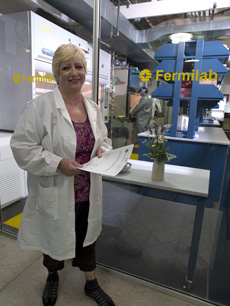
Donna Hicks - Chemical Hygiene Officer in the Technical Division
"Safety starts days or weeks before the actual job. Think through the job and all the possible hazards that could emerge. Make a plan and a backup plan to deal with each hazard. Don't wait until you are in danger to realize you aren't prepared."
See all Fermilab Profiles in Safety here.
|
Practice makes perfect for NuMI repair crew
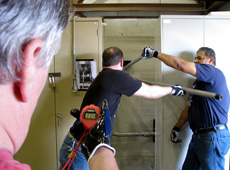
AD mechanical support team members work on a mock up drill to replace a NuMI horn water line. Jim Folkie, senior technician, records the time it takes Keith Anderson, senior technical aid, and Orlando Rivera, contract technician, to tighten a bolt.
Keith Anderson presses his NFL regulation receiver gloves on tighter. They allow for a good grip, which is crucial, since the slightest slip on a wrench could cost a second, and seconds are precious for Anderson and the rest of the NuMI repair crew.
During the shutdown in October, the NuMI repair crew changed a faulty 60-inch section of suction water line from NuMI's focusing horn 2. The horn focuses pions that later decay into neutrinos. It has become radioactive as a result of beam particle interaction.
Fermilab wants the men near it for as short a time as possible. The repair team's goal is to follow the laboratory practice of ALARA in keep individual exposure levels as low as reasonable achievable. They take pride in cutting seconds off the total repair time, to reduce personnel radiation exposure levels, without sacrificing safety. The crew was able to keep their exposure at 25 percent of their laboratory's exposure goal for this task.
The secret is practice and team work. When the 50,000 pound beamline positioning module and its associated focusing horn are removed from the beamline, it must hover partially inside the work cell during the repair process. But the men can't risk radiation exposure or damaging the horn by practicing in the target hall cavern, so they built a mock work cell above ground prior to the repair.
Read more
-- Tona Kunz
|
The path more travelled by: grids help track human migration
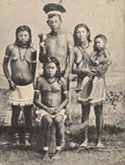 |
| Nicolas Ray uses Approximate Bayesian Computation-developed in 2002-to track the migration of humans through the centuries.
Images courtesy of Rakesh Rampertab |
Today, families interested in an intercontinental move will probably go by plane, train or automobile. Several thousand years ago, adventurers had a harder time of it.
Thanks to the plucky, pioneering efforts of early families, humans have managed to explore and settle every habitable region of the globe.
Surviving the "bottlenecks"
Two ancient migrations have particularly affected the shape of future generations: the "Out of Africa" event and the North to South colonization of the Americas. These migrations left traces in our genes still observable today.
Described as "bottlenecks"-events where only a few individuals get through-the migrations may have caused a drastic reduction in population size and a corresponding drop in genetic diversity.
To estimate the strength and timing of these bottlenecks, specialists like Nicolas Ray at the Computational and Molecular Population Genetics Lab at the University of Bern, Switzerland, try to reconstruct past human movements using the genetic diversity of current populations.
Read More
-- Danielle Venton, EGEE
|
Tape shows how physicist predicted parallel worlds
From The Guardian, Nov. 26, 2007
The only known recordings of a brilliant physicist who predicted the existence of parallel universes have been found in the basement of his rock star son's flat.
The tapes document how Hugh Everett, a quantum physicist, developed his idea at the age of 24, while a graduate student at Princeton University in 1957. Everett's theory gave rise to the concept of a multitude of universes, or a "multiverse", where all life's possibilities play out. It means that somewhere Elvis is still rocking, the Nazis won the second world war and England qualified for Euro 2008.
Read More
|
|
|
Never trust billiard ball
b-quark physics
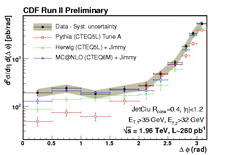
Δφ distribution between the two b-jets. The data is compared to Leading Order and Next to Leading Order predictions
B-quarks, like all other quark types, are known to be produced at the Tevatron mostly in pairs. The simplest description of such an interaction is that the two b-quarks are produced back-to-back and travel in opposite directions in the detectors, such as two balls moving apart after they are hit against each other. It is also possible that together with the two b-quarks other fundamental particles, such as gluons, are produced. The rules of billiards are more complicated at Fermilab since particles can be created from the enormous collision energies: imagine hitting the eight ball and having three balls fly out of the collision. At Fermilab, this means that the b-quarks are no longer produced back-to-back. Thus, measuring the angle between the two b-quarks provides an excellent handle to help understand the mechanisms behind b-quark production.
B-quarks are identified by observing b-jets in the CDF detector. B-jets are groups of particles traveling mostly in the same direction that seem to originate not from the main interaction point but from a small distance away. Using the silicon vertex trigger, the CDF triggering system is able to recognize, in real time, when a charged particle was likely to originate from the decay of a heavy flavor quark. This powerful tool also ensures that such events are saved for physicists to look at.
Using data collected by this specific trigger, CDF physicists were able to measure the distribution of the angular separation between the two b-jets. The distribution was then compared to various theoretical predictions. They found that using the simplest predictions, called Leading Order, was not sufficient to describe the data. But when comparing the data to a model that better takes into account the production of other particles along with the two b-jets, called Next to Leading Order, the agreement is found to be reasonable.
Next time you go to play billiards at Fermilab's Users' Center, make sure your theory is good enough, or you might end up getting hustled.
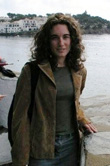
Sofia Vallecorsa (University of Geneva)
Read more
Result of the Week Archive
|
|
Have a safe day!
NALWO holiday Chicago trip Dec. 1
Join NALWO on Saturday, Dec. 1, on a trip to Chicago to see colorful
decorations and enjoy shopping, music and entertainment at the German/American holiday festival, the "Christkindlmarket" at Daley Plaza. Shop at the State Street department stores, see Macy's animated windows or try your skills at the Ice Skating Rink at Millennium Park. The bus will leave from the Lederman
Science Center at 10 a.m. and will return by 4:30 p.m. There is a $5 charge for adults and $2 for kids age 3 to 14. To register or for further
information, please contact Selitha Raja at (630) 305-7769.
Employee art show this spring
Another inspiring art exhibition by Fermilab employees and immediate family members will take place this spring. "Hidden Talents: Fermilab Employee Art Show" will be on display,
March 19, 2008 - May 14, 2008. More information will follow.
Seasonal holiday student requests
Managers who would like to bring back their summer students for holiday seasonal employment can access information and a request form here. Only students who were summer 2007 employees are eligible. Students who were on-call must return as on-call workers.
Education Office holiday sale Dec. 4-6
The Education Office will host its annual holiday sale Dec. 4-6, from 11 a.m. to 1:30 p.m., outside One West in Wilson Hall.
Fermilab Basketball League
Basketball League play begins today, Nov. 29, in the gymnasium at the Recreation Facility. Games are played Thursday evenings beginning at 5 p.m. Contact Ryan Schultz at X6571 or e-mail if you are interested in participating. Current Recreation Facility membership required.
Blood Drive Dec. 18, 19
Mark your calendars. Heartland Blood Centers will be here for the Fermilab Blood Drive on Dec. 18 and 19, from 8 a.m to 2 p.m. in the
Wilson Hall Ground Floor NE Training Room. Appointments can be scheduled on
the Web or by calling Diana at x3771 or Margie at
x5680. More information can be found here.
Additional Activities |
|